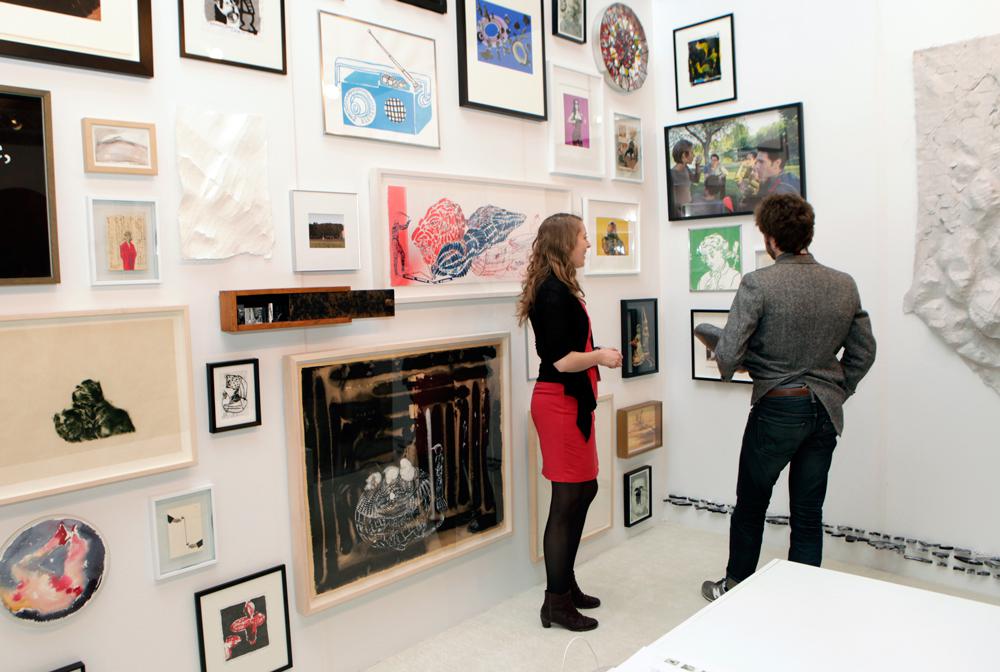Change is on the horizon at Montreal’s Papier, the Association des galeries d’art contemporain’s lynchpin art fair, which focuses on paper-based artworks. Yesterday, amid preparations for the opening of the fair’s eighth iteration this Thursday, AGAC announced that longtime director Julie Lacroix would be taking a maternity leave, with Christine Blais filling in as interim director. And the changes are not limited to staff shuffles. Moving from its usual tented location in a vacant lot near Place des Arts, Papier will be housed this year within the Complexe de Gaspé, an artist-run hub in the more bohemian, yet rapidly gentrifying, Mile End neighbourhood just north of the city’s downtown core.
With new leadership, a different location, expanded programming and mounting competition (in the newly launched Art Contemporain Pour Tous, also on view this weekend), the question looms: can Papier maintain its reputation as a discerning fair that manages to mete out quality without abandoning accessibility?
At the outset, Papier’s stable of loyal collectors seems far from phased. Montreal-based collector Pascal Desjardins, for one, isn’t dissuaded. “From the first day I began collecting,” he says, “I have never missed an edition.” Planning his trip again this year, Desjardins notes, “It’s my fourth year at Papier.” Even collectors who began attending recently, such Calgary’s Greg and Karen Pedersen, seem amiable about the developments. “This will be our second trip to Montreal for Papier,” explained Greg, and, far from a detriment, the proposed changes are enticing. “In the past it has been in a tent closer to downtown,” noted Greg, “so this will be a little bit nicer with the facilities. It’s a little bit further away from downtown, but I don’t think that’s going to be a problem.” For Calgary collector and past attendee Dell Pohlman, the new location was a draw: “I would have loved to have seen Papier in its new and larger location.”
There are also significant shifts in the fair’s programming, with the addition of a video-screening room. For Pohlman, whose plans to attend the fair were cancelled recently due to work commitments, this expansion was a welcome change. “I was especially looking forward to the video programming,” he said. “Video works are one of my interests as a collector, so I’m sad to be missing that.” It’s a shift that works for collectors like Pohlman, but could also signal a slight overreaching for a fair that has in past staked its reputation on a focused approach to works on paper.
Few of the collectors attending the fair limit themselves to works on paper, so perhaps a more expansive approach to material will land the programmers in good stead. For both Pohlman and Desjardins, Papier introduced them to new works by artists they already collected. “I remember falling in love with a nice Martin Bourdeau piece from Galerie Division,” remarked Desjardins. “A painting on paper from his series of scenes through a window screen.” Likewise, Pohlman saw the breadth of Micah Lexier’s paper projects at the fair.
With a limited roster of 39 galleries (a slight decrease from 2014’s 44 galleries), the 2015 instalment should retain its intimate scale—welcome news to collectors, who almost universally praise the fair’s sheer navigability, especially in contrast to increasingly spectacularizing international fairs. “It’s a little bit smaller than the Toronto fair,” noted Greg Pedersen, “and a little bit easier to get around and look at everything.” For Pohlman, “Papier felt more democratic and intimate,” a sensibility that afforded him the chance to “meet dealers and see new art.” The scale, and its accordant atmosphere, attracted Desjardins as well: “There’s something exceptional about the event; there’s tons of good art, of course, but there’s really that friendly, convivial and festive atmosphere.”
And among these 39 galleries, there are plenty of collector favourites. The Pohlmans will be on the lookout for pieces by Ken Nicol, now represented by Olga Korper Gallery, and Pierre-François Ouellette art contemporain’s booth. Desjardins will be watching for works by the likes of Trevor Gould, Kim Dorland and Tammi Campbell (in and among the programming Desjardins is leading at the fair, including a tour on the nuts and bolts of collecting).
Of course, in the midst of all the changes to the fair, it retains one of its most abiding attributes—Montreal itself. It’s a winning location; take the Pedersens, who admit that their first visit was largely destination-based. “We noticed some advertising for the fair and we always enjoy visiting Montreal,” Greg said. “So it seemed like a good excuse.”
Let’s hope the offerings match their surroundings.

 Galerie Joyce Yahouda's booth at Papier13 in Montreal. Photo: ARHphoto.
Galerie Joyce Yahouda's booth at Papier13 in Montreal. Photo: ARHphoto.







